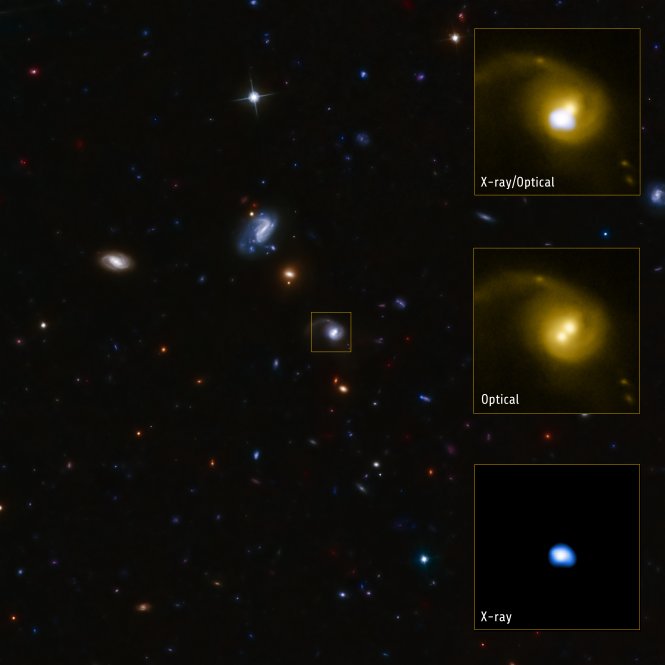We're open daily! View holiday hours
Science News
Black Hole Ejected from Galaxy
June 22, 2012
by Alyssa Keimach

This strange looking galaxy has some explaining to do! Unless Einstein has already explained it…
The galaxy CID-42 lies four billion light years away. The Hubble Space Telescope returned a visible-light picture of the galaxy with two bright areas—one in the center and the other a bit offset. The mystery expanded when NASA’s Chandra x-ray telescope revealed that only the offset bright spot emits x-rays.
The high-energy radiation from the off-center bright spot provides evidence of at least one supermassive black hole consuming gas (and emitting all that radiation). But what does that make the other spot?
Scientists have proposed two ideas about the nature of the bright spots: both hypotheses emerge from the assumption that a galactic merger took place between two galaxies, each of which had a supermassive black hole at its core.
The first, rather straightforward explanation is that the central bright spot is simply another black hole, just like the off-center bright spot, except that dust obscures the high-energy radiation from the central black hole.
The second explanation suggests that a galactic merger resulted in the two supermassive black holes colliding, creating an even more massive black hole—several million times more massive than the Sun. The gravitational waves from this collision could have created a kick, sending the massive black hole on a path out of the galaxy. If this happened, then the central bright spot would be an area of star formation, emitting no high-energy radiation at all.
“It’s hard to believe that a supermassive black hole weighing millions of times the mass of the Sun could be moved at all, let alone kicked out of a galaxy at enormous speed,” says Francesca Civano of the Harvard-Smithsonian Center for Astrophysics (CfA), who led the new study. “But these new data support the idea that gravitational waves—ripples in the fabric of space first predicted by Albert Einstein but never detected directly—can exert an extremely powerful force.”
Einstein proposed that an extremely massive object—for example, a supermassive black hole—accelerating through space would create ripples in space-time, taking the form of asymmetrical gravitational waves. This would send the black hole recoiling in the opposite direction of its emitted gravitational waves.
Although the ejection of a supermassive black hole from a galaxy occurs rarely, this observation could still indicate that many giant black holes roam undetected in the vast spaces between galaxies.
“These black holes would be invisible to us because they have consumed all of the gas surrounding them after being thrown out of their home galaxy,” says co-author Laura Blecha, also of CfA. An oddly haunting thought…
A video of CID-42 can be seen here.
Alyssa Keimach is an astronomy and astrophysics student at the University of Michigan and volunteers for the Morrison Planetarium.
Image: X-ray: NASA/CXC/SAO/F.Civano et al; Optical: NASA/STScI; Optical (wide field): CFHT, NASA/STScI